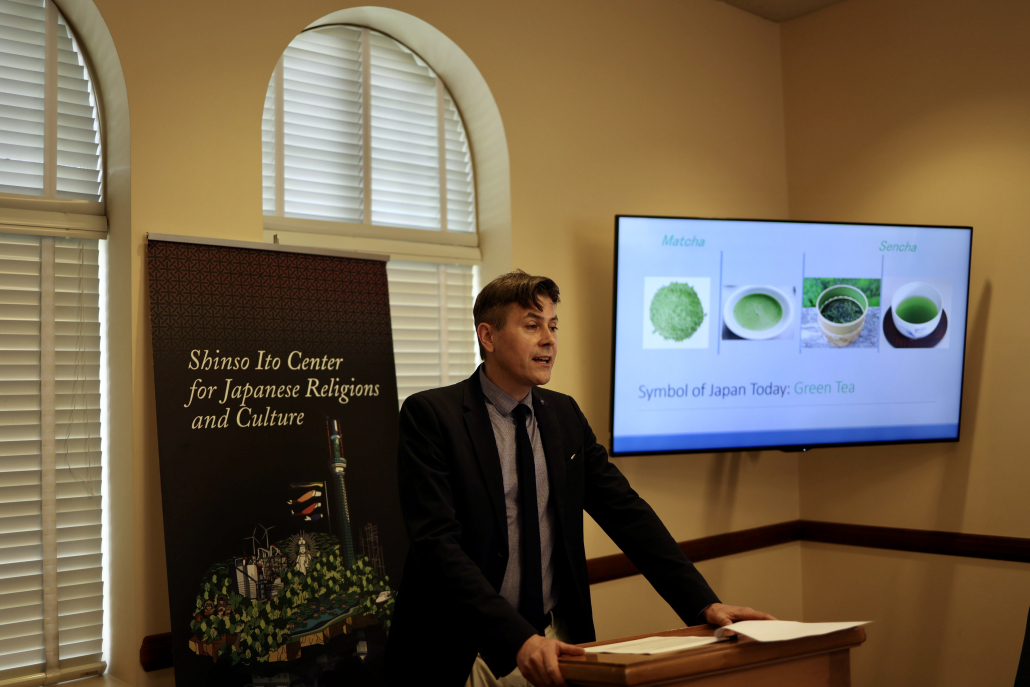Guest author talks history of green tea

Robert Hellyer, author and associate professor of history at Wake Forest University, discussed his new book “Green with Milk and Sugar: When Japan Filled America’s Tea Cups” at Doheny Memorial Library Monday. Hellyer’s book navigates a dedicated history to green tea and provides a personal narration of his family’s tea-processing factories.
The event, co-sponsored by USC Libraries, the USC Department of History and green tea company ITO EN North America marks the first in-person talk for the Shinso Ito Center for Japanese Religions and Culture since March 2020.
Hellyer, whose family shares a personal relationship with tea through their tea processing factories in the Japanese port cities of Shizuoka and Kobe, said his maternal grandmother reserved green tea for guests and coffee for Hellyer because green tea was a sophisticated, elevated beverage.
“As my grandmother and I sat on lawn chairs savoring the aroma of freshly cut grass, she often talked of her time in Japan in the early 1930s as the wife of a tea merchant,” wrote Hellyer in his book. “Much of what propelled me to write this book was a desire to delve beyond the anecdotes from those summer days and to learn more about the worlds of my grandmothers.”
Tea classifications, Hellyer said, can be discerned by oxidation levels and is categorized as green tea — subcategorized into sencha, bancha and matcha — oolong tea and black tea, the latter the most oxidized of the teas. Hellyer said there is a presupposition that America has no standard tea conduct, but green tea was at the center of it.
“Many American families, particularly young girls, will be encouraged to have a tea set or have tea time, but we don’t have coffee time in the same way,” Hellyer said. “Starbucks has its own nice, everyday elegance, but it’s not the sophistication.”
Tea consumption patterns in the 1850s demonstrated that American consumers and even former United States presidents continued to drink green tea following the Boston Tea Party and the American Revolution, Hellyer said. Sentiment for green tea didn’t wane until the postwar era, when anti-Japanese and anti-Chinese views spawned from propaganda.
“While Britons preferred black teas, after 1800, in the United States, green tea came to hold an aura of sophistication and was more widely consumed,” Hellyer said. “Green tea was sold at higher prices than black tea.”
Indian Ceylon, a competitor to Japan Tea — the first national brand of green tea in the U.S. — sought to sell its black tea to the U.S. market following a successful introduction into British society. Indian Ceylon altered Americans’ tastes from green to black teas with a strategy that involved negative advertising with racist overtones presenting both Japanese and Chinese green teas as “dirty, dangerous and fraudulent,” Hellyer said.
“These advertisements had some impact in reducing American consumption of Japanese green tea but not immediately,” Hellyer said. “That’s because the war disrupted Indian Ceylon exports, so Japan was able to export more tea to Britain and other European markets.”
In bolstering black tea’s reputation, Indian Ceylon contended that their tea was better quality because it was picked and refined by white individuals, which had long-term impacts on American consumption of Japanese green tea, Hellyer said.
Rebecca Corbett, co-head of the East Asian Library, associate University librarian and moderator of the event, said that, amid rising anti-Asian hate regarding coronavirus origins, conversations about historical instances of anti-Japanese and anti-Chinese perception that parallel modern trends are crucial to observing positive examples of interaction between North America and Asian countries.
“A lot of Japanese Americans found it difficult, initially, to live in America and to not have that negative associations because of their heritage,” Corbett said. “We are looking at the economic and cultural history of tea as a product in America … the popularity of it over time and people’s image of Japan and how that can be bound up … in Japan as a branding symbol.”
Lindsay O’ Neill, who attended the lecture with students from her “General Education Seminar in Social Analysis: Drunk History, or How Beverages Changed the World” class, said beverages can tell a significant story about Westward expansion and colonization facilitated by corporations.
“It’s a smaller way to look at these long term changes,” said O’Neill, an associate professor of history at the Dornsife College of Letters, Arts and Sciences. “Hopefully, it makes people think, and USC students think more critically about what’s on their plate.”
Issay Matsumoto, who asked a question about advertisements’ role of promoting sencha as a “health product” to stimulate export numbers, said he attended the talk because of his intrigue with tea, which stems from his desire to learn about Japanese products’ influence in Asian markets.
Depending on the geopolitics of the time, tea can be culturally valued or devalued depending on its origin, Matsumoto said. From the experience, Matsumoto drew takeaways about consumption and production patterns across waters from Hellyer’s research and personal anecdotes.
“You can tell histories close to you because the speaker’s own family history is linked to this. So, you can tell stories about your own family in really big, interesting ways,” Matsumoto said.

